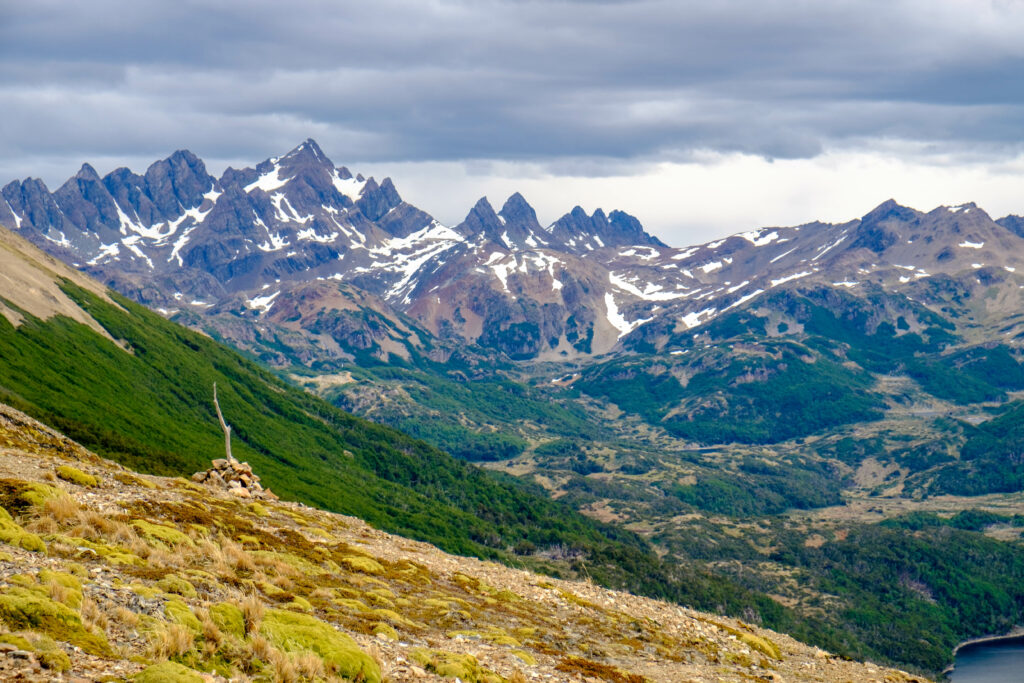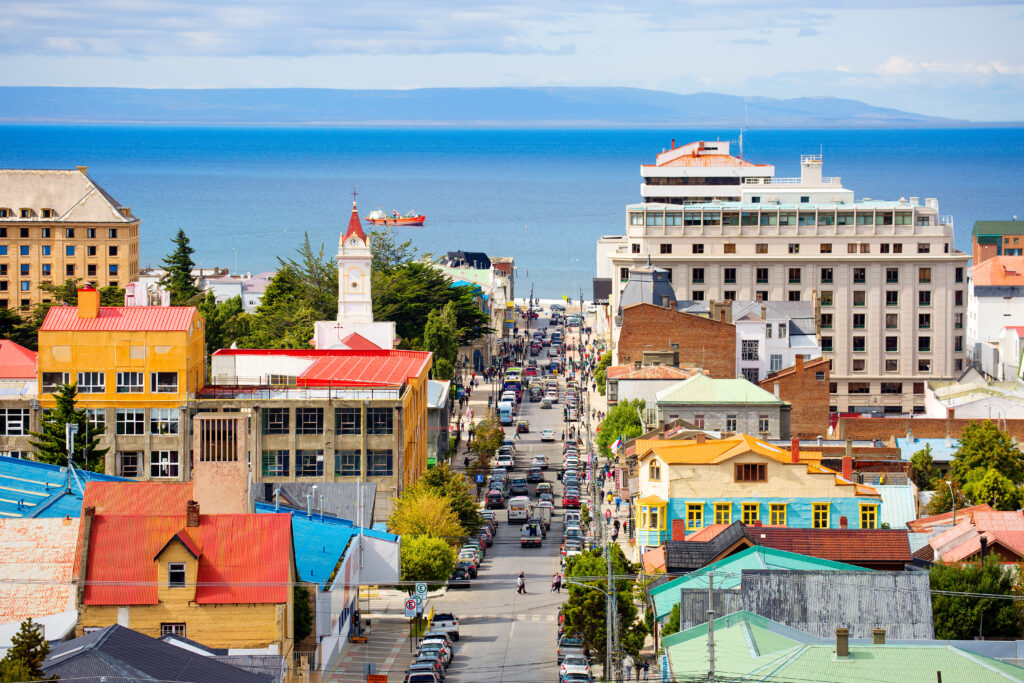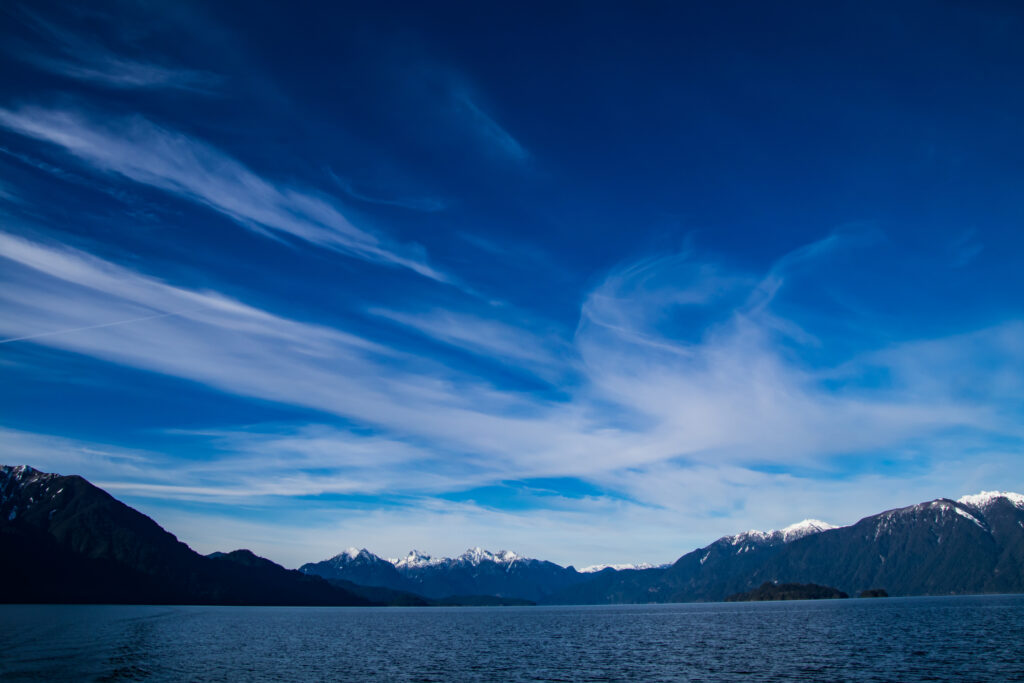
Chilean Patagonia is one of the world's wildest and most unspoilt regions, offeringbreathtaking scenery. With its rugged coastline, winding roads, dense forests and immense ice fields, this region is a veritable spectacle of nature. Once known as the "End of the World", visiting Patagonia today is much more accessible, but this in no way diminishes its magic, for Patagonia remains a unique and breathtaking place. In this article, we present a selection of the 17 most beautiful places to visit in Chilean Patagonia, to help you plan your trip to this extraordinary region.
1. Torres del Paine National Park: the jewel of Chilean Patagonia

The jewel of chilean Patagonia. It's impossible to talk about Chile without mentioning the magnificent Torres del Paine National Park, which attracts thousands of visitors every year. Classified as a biosphere reserve by UNESCO, the park boasts a rich ecosystem and breathtakingly beautiful landscapes. Stretching over 227,298 hectares between the Southern Patagonian Icefield and the Patagonian Steppe, it is home to impressive glaciers, including the famous 6-kilometre-long Grey Glacier, whose icebergs reach 30 metres in height. It's not uncommon to come across guanacos, cousins of llamas, and many other species in this massif. Many visitors come to Torres del Paine National Park to fish or admire the magnificent flora, often threatened by human activity.
2. puerto Williams: the perfect base for visiting Tierra del Fuego

Once a simple collection of military barracks, Puerto Williams has recently been transformed into an essential stopping-off point for cruises to Antarctica. Its charm lies mainly in its geographical location: as of 2019, it is the southernmost town in the world. From here, it's possible to explore numerous national parks and nature reserves, offeringincredible landscapes and endemic flora and fauna. Must-sees include Isla Magdalena National Park, home to the world's largest colony of Magellanic penguins, and Cabo de Hornos National Park, famous for its gigantic glaciers, including Balmaceda.
Petit Futé tip:If you're tempted by a vacation in Argentine Patagonia, book your travel insurance here at a discountedrate and leave with peace of mind!
3. Patagonia Park: one of Patagonia's richest biodiversities

In 2019, a new private park came into being in the heart of a sublime Patagonian valley, under the aegis of the Tompkins couple, who also created the Pumalín park north of Chaitén. Its forests, steppes and mountains are home to some of the richest biodiversity in Patagonia. Pumas, huemuls and rheas are gradually reclaiming their territory, which is good news for the ecological balance of the region, which has long been dominated by sheep farming. The park is dedicated to the protection of Patagonia's steppe, rugged mountains and endangered exotic species.
You may also be interested inWhat to do in Chile The 17 most beautiful places to see and visit
4. What to do in Chilean Patagonia? Hike the Osorno volcano in Petrohue

The Osorno volcano, with its majestic, conical silhouette, is the perfect embodiment of the image we have of a volcano. Rising to 2,652 metres, this stratovolcano lies between Lake Todos los Santos to the east and Lake Llanquihue to the west. Formed over the last 200,000 years, its summit is crowned by a glacier and a crater whose diameter varies between 250 and 300 metres. Although dormant since 1869 - Charles Darwin even observed its last eruption - the Osorno volcano now attracts many tourists who come to enjoy skiing and hiking.
You may also be interested inWhere to go hiking? The best destinations and 10 unforgettable hikes around the world.
5. Puerto Montt: a must-see in Chilean Patagonia

One of the must-sees in Puerto Montt starts with a visit to the mariscos y pescados (seafood and fish) market , where local produce is lovingly prepared! Linger over the Greek silhouette of Puerto Montt Cathedral, pass by the Manuel Montt viewpoint and head for the fascinating Monte Verde archaeological site, where traces of human habitation dating back 14,500 years have been found! Then head for the Presidente Ibañez market (in the upper part of Puerto Montt) or Angelmó, a bustling port area. From here, we recommend a visit to the Monumento Natural Lahuén Ñadi ecological park, before heading to Tenglo Island: after a 5-minute crossing, you're in the middle of nature, with a view of Puerto Montt and the volcanoes of the Cordillera...
Good to know: Several companies offer unforgettable cruises from Puerto Montt (from half a day to a week) aboard ferries sailing in the Lakes region, along the Chiloé coast (Ayacara, Castro, Chaitén) and the Puerto Aguire fjords, to the Aysén and Magallanes regions. A magnificent journey between the blue of fresh and salt water, the fresh white of eternal snow, the green of the southern forests and the brilliant light of the Patagonian sun.
6. Discover Chiloé, Chile's enchanted island

The second largest island in South America (behind Tierra del Fuego), Chiloé is made up of ten municipalities - Ancud, Castro, Dalcahue, Chonchi, Puqueldón, Queilén, Curaco de Vélez, Quinchao, Quellón, Quenchi - and some forty smaller islands listed by UNESCO. Chiloé is one of Chile's most spectacular territories. Each island and municipality offers numerous festivals, activities, fascinating museums and quality craft markets, including Tejedoras, local decorative textiles.
What to do : for sports enthusiasts, several agencies offer excursions including kayaking on the Ríos Chepú and San Antonio, hiking and mountain biking. Among the classic tours, we recommend a visit to the pingüineras, particularly Puñihñuil, one of the few Chilean sites where two species of penguin cohabit - the Magellanic and Humboldt penguins - both on the brink of extinction.
Related article: Puerto Montt and the Chiloé archipelago, vibrant southern Chile
7. What to do in Chilean Patagonia? Visit Chiloé's famous churches

The island's coastline is home to a collection of 16 churches built by the Chiloé school of wooden religious architecture, all of which are UNESCO World Heritage Sites. Among the most beautiful are those of Dalcahue - a village famous for its craft fair, where you can taste asado al palo (lamb on a spit) - Achao and Caraco de Velez (Isla Quinchao), with their quiet beaches and fresh oysters, and Castro (the church is monumental: 52 m by 27 m), the dynamic capital of Chiloé and an ideal base camp for exploring the south of the archipelago. Here you can stay in a palafito, a typical house on stilts that follows the movement of the tides without ever wavering.
Good to knowwould you like a personalized itinerary for your trip to Chilean Patagonia? We recommend that you request a free quote right here. A tailor-made, responsible trip, direct with the best local agencies, awaits you!
8. Mechuque Island, one of the most fascinating islands in the Chiloé archipelago

Mechuque is one of the most fascinating islands in the Chiloé archipelago, part of the Islas Chauques. Here you can discover the most beautiful palafitos (houses built on stilts) and a charming wooden bridge. To get there, boats leave from Dalcahue (allow 2 hours for navigation). This is a magnificent island, far removed from Chiloé's traditional tourist circuits! You can also take a lancha to Tenaún, on the road to Quemchi (only 45 minutes' sailing).
You might also be interested in What to do in Argentine Patagonia The 17 most beautiful places to visit and What to do in Argentina? The 17 most beautiful places to visit
9. Achao: the main village on Quinchao Island

This is the main village on Quinchao Island, a pleasant island that has retained its rural character. In Achao, you can admire the church of Santa Maria de Loreto, built of cypress and alerce and a UNESCO World Heritage Site. In the heart of the village, you can also admire the larch roofs of the houses. Achao is a pleasant stopover, where you can enjoy the peace and quiet of a small fishing port nestled in a pretty bay.
10. Lemuy Island: a small island with a special charm

Declared "Best Tourism Village" by UN Tourism in 2022, Lemuy Island is a small island with a special charm, offering superb scenery and three UNESCO World Heritage-listed churches. Just 4 kilometers from the landing stage, the church of Ichuac is well worth a visit, as are the chapel of Aldachildo (built in 1910 of cypress and coigüe), located shortly after the village of Puqueldón, and the church of Detif at the tip of the island. The beaches of Apabon and Punta Pilar, near Detif, are particularly pleasant with their white sand. A number of viewpoints offer magnificent vistas of the archipelago.
You might also be interested in10 destinations for total relaxation
11. Trek in Tantauco Park

Tantauco Park covers over 110,000 hectares and is home to peat bog landscapes and a native forest rich in las Guaitecas cypress. It is divided into three sectors, each of which can be visited in a day. For the more adventurous, long trails dotted with refuges lead deep into the park, requiring between 4 and 9 days' hiking.
- Yaldad sector: Just 18 km from the junction of Route 5 South, you'll find the Yaldad Visitor Center, the Grand Mañío Abuelo, the Siempreverde, the Yaldad River Trail and the Darwin Trail.
- Chaiguata sector: 38 km from the Ruta 5 Sur junction, 1 hour from Yaldad. On-site restaurant open in summer. There are two trails: Bosque Hundido (2 hrs.) and Los Ñirres (3 hrs.). You can also kayak on Lake Chaiguata.
- Inio sector: An excursion to the most remote corner of Chiloé. By plane from Club Aéreo de Castro, you can reach Inío in 40 minutes. By boat, departures are twice a week and the trip takes around 5 hours.
12. Puerto Natales: an emblematic stop on your trip to Chilean Patagonia

What to do in Chilean Patagonia? Puerto Natales is an emblematic stopover and departure point for the fabulous Torres Del Paine National Park and the Patagonian canals. Founded in 1911, the town lies between the Almirante Montt Gulf and Ultima Esperanza Bay. It is reminiscent of Punta Arenas in the architecture of its small houses with multicoloured corrugated iron roofs, but does not have the same administrative and economic importance. Nevertheless, the atmosphere is cosmopolitan and pleasant, and the landscapes are melancholy and wildly beautiful.
You might also be interested inNature destinations to discover around the world
13. Punta Arenas: a mysterious attraction for travellers

The name Punta Arenas conjures up legendary tales: the discovery of the Strait of Magellan, the epic journey of pioneers to this land where nature is hostile to man, and the great fortunes of families who owned sheep farms. Today, this city of 125,000 inhabitants has lost some of its former splendor, but it still exerts a mysterious attraction on travelers, nourished by the tales of Chatwin or the works of Coloane and Sepúlveda.
Good to know: the city itself is rarely visited. Several agencies offer excursions to nearby sites of interest. In particular, you'll be able to discover the nature and national parks that make it a must-see destination.
14. The River Region: a must-see in Chile

The Rivers region, located in southern Chile, is a must-see destination for lovers of nature and spectacular scenery. This region, also known as Los Ríos, is characterized by its many rivers, dense forests and majestic volcanoes. Valdivia, the capital, is a unique combination of nature and culture. The surrounding area offers superb excursions, immersing visitors in the history of the conquest of Chile. Last but not least, the wild beaches and small fishing harbors in the surrounding area offer wonderful walks off the beaten track.
The Rivers region is also renowned for its national parks, such as Puyehue National Park, home to breathtaking volcanic landscapes and rich biodiversity.
15. What to do in Chilean Patagonia? Visit the Lake District

Chile' s Lake District conjures up images of volcanic cones capped with eternal snow, lakes studding valleys planted with thousand-year-old cypress trees, Mapuche traditions... Must-see destinations include Puerto Montt, the gateway to the region, and Puerto Varas, a charming town on the shores of Lake Llanquihue, with a breathtaking view of the Osorno volcano. You can enjoy a wide range of outdoor activities, including hiking, kayaking, fishing and skiing. The region is also renowned for its national parks, such as Vicente Pérez Rosales National Park, the country's oldest park.
Related article: Chile, between volcanoes, lakes and Chilean myths
16. The Strait of Magellan

Located at the southernmost tip of the South American continent, the Strait of Magellan separates it from the Isla Grande of Tierra del Fuego. Named in honor of the famous Portuguese navigator who was the first European to discover it in 1520, it is known today for its strategic position between the Atlantic and Pacific oceans. We recommend atrip to the San Isidro lighthouse , where you can contemplate the whales and dolphins in the strait - you'll feel like you've stepped out of time. You can also kayak on the strait among the dolphins and sea lions. It's a magical experience of a lifetime!
17. Cape Horn at Parque Nacional Cabo De Hornos

This national park, a privileged refuge for a rich and varied flora and fauna, is best known for its famous Cape Horn. It encompasses the Wollaston and L'Hermite archipelagos, including Horn Island and its famous cape, which has become a veritable marine cemetery. Nearby is a memorial, represented by a majestic albatross sculpture, to the many sailors who perished attempting to round the cape. Today, Cape Horn can be crossed by boat on cruises departing from Ushuaia or Punta Arenas. The cruise line usually gives passengers a Cape Horn certificate, to immortalize this mythical passage.
What's the budget for two weeks in Patagonia?
The budget required for two weeks in Patagonia varies according to a number of factors, including the type of accommodation, activities chosen, travel and meals. Here's a general estimate to help you plan your trip:
Accommodation
- Mid-range hotels: Approximately €70 to €130 per night. For two weeks, this represents approximately €980 to €1,820.
- Youth hostels: Around €18 to €35 per night. For two weeks, this represents approximately €252 to €490.
- Camping: Approximately €9 to €18 per night. For two weeks, this represents approximately €126 to €252.
Transport
- Internal flights: Flights between Buenos Aires and the main cities of Patagonia (such as Ushuaia, El Calafate, Bariloche) can cost between €175 and €440 per trip.
- Car rental: Approximately €26 to €44 per day. For two weeks, this represents around €364 to €616.
- Bus: Bus fares vary, but you should expect to pay between €44 and €88 for long-distance journeys.
Activities
- Excursions and guided tours: Excursions to glaciers, national parks and other attractions can cost between €44 and €175 per day. For two weeks, this represents around €616 to €2,450.
- Entrance fees to national parks: Approximately €9 to €26 per park.
Meals
- Mid-range restaurants: Approximately €18 to €35 per meal. For two weeks, this represents approximately €490 to €980.
- Value meals: Approximately €9 to €18 per meal. For two weeks, this represents approximately €252 to €490.
Estimated total
- Accommodation: €126 to €1,820
- Transport: €364 to €1,056
- Activities: €616 to €2,450
- Meals: €252 to €980
Grand total
- Budget: Approximately €1,358
- Mid-range budget: Approx. €2,610
- High-end budget: Approx. €5,306
When is the best time to visit Patagonia?
The best time to visit Patagonia depends on your interests:
- For hikers and nature lovers: Spring (September to November) and autumn (March to May) are often the best periods, with moderate temperatures and fewer tourists.
- For winter sports enthusiasts: Winter (June to August) is the best time to enjoy snow activities.
- For those who prefer long, warm days: Summer (December to February) is ideal, but be prepared for bigger crowds and higher prices.


